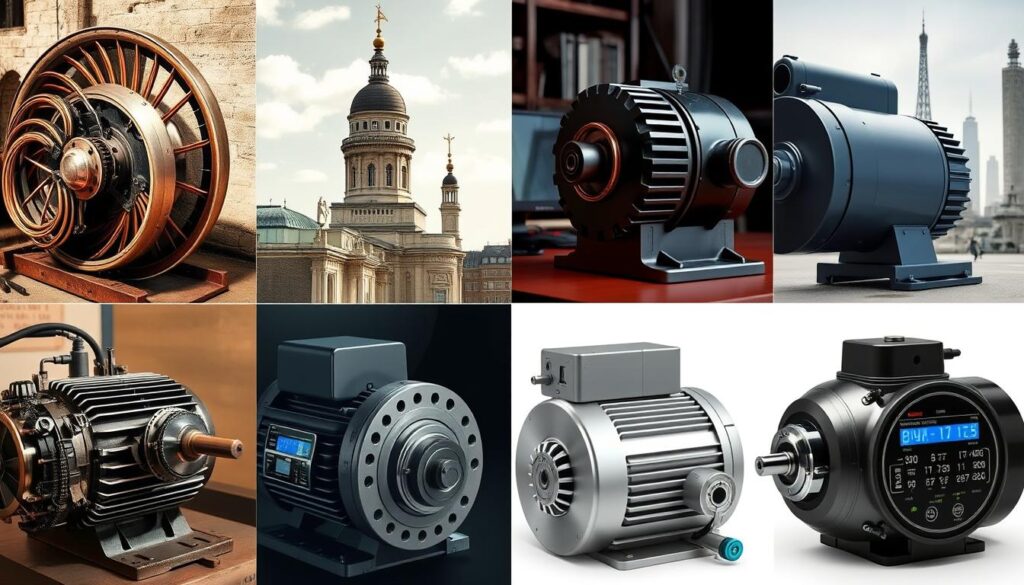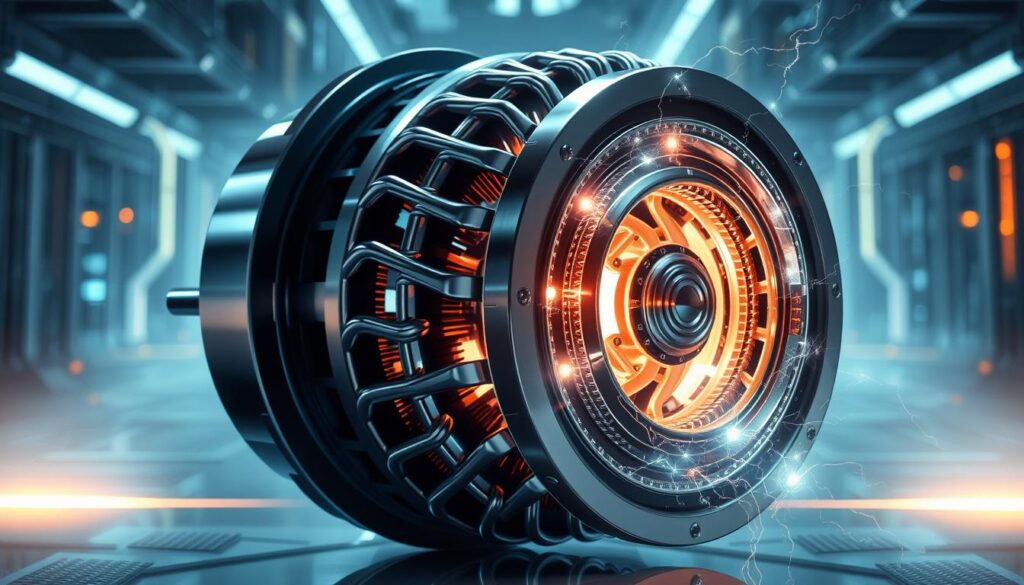In This Guide
The history of electric motors is full of scientific breakthroughs and technological leaps. Since the 1800s, these motors have changed our lives. They power many of the modern conveniences we take for granted.
From the early days of electromagnetic experiments to the work of visionaries like Michael Faraday, electric motors have come a long way. This journey shows how far electrical engineering has come.

Key Takeaways
- Explore the rich history of electric motors dating back to the 1800s
- Discover the groundbreaking discoveries and innovations that paved the way for modern electric motor technology
- Gain insights into the pivotal role of pioneering scientists and their contributions to the development of electric motors
- Understand the significance of electric motors in the technological advancements of the modern era
- Appreciate the ongoing evolution and future potential of electric motor technology
The History of Electric Motors: From Discovery to Innovation
The story of electric motors began in the early 19th century. Groundbreaking discoveries in electromagnetism led to their development. Scientists like Hans Christian Oersted and André-Marie Ampère made key discoveries. They showed how electricity and magnetism are connected.
Faraday’s Revolutionary Contributions
Michael Faraday was a key figure in this progress. In 1831, he discovered how a changing magnetic field can create an electric current. This discovery changed the game for electric motors.
First Practical DC Motors Development
After these discoveries, inventors started working on the first practical DC motors. Thomas and Emily Davenport were among the pioneers. They made motors that could power machinery and even transportation.
The journey of electric motors shows the power of science and innovation. From the first experiments to the first practical motors, it’s a story of progress. This progress has led to the modern marvels we use every day.
Evolution of Motor Technologies in Modern Era
The late 19th and early 20th centuries saw big changes in electric motor tech. Nikola Tesla and George Westinghouse led the way. They created AC motors that changed how industries worked.
Tesla’s AC induction motor, introduced in 1888, was a game-changer. AC motors were more efficient and cheaper to run. They were also simpler to fix, making them a top pick for many uses.
Westinghouse built on Tesla’s work, making AC motors even better. He made induction motors popular in many fields. These motors were more reliable and lasted longer because they didn’t need brushes and commutators.
In the 20th century, the brushless DC (BLDC) motor came along. These motors use permanent magnets and electronic controls. They were more efficient and needed less upkeep than old motors. BLDC motors are now in many things, like home appliances and cars.
People have always wanted to make motors better. New materials and ways to make motors have made them more efficient. AC motors, induction motors, and brushless DC motors are now used in many areas. This includes factories, cars, and even green energy and robots.

“The future will be electric, and the motors that power it will be the heart of that revolution.”
As we move towards a greener future, electric motor tech will be key. It will help us use less energy and make new, cool things possible in many fields.
Conclusion
The journey of electric motors has been amazing. It’s filled with key discoveries and big steps forward. These changes have greatly shaped our world.
Looking ahead, electric motor tech is set to get even better. This is because we need cleaner energy sources. Scientists and engineers are working hard to make these motors more efficient and reliable.
Electric motors are becoming key in using green energy like wind and sun. This shows how new tech can help us live in a cleaner world. By using electric motors with renewable energy, we can use less fossil fuels. This brings us closer to a greener future.
FAQ
What is the history of electric motors?
Electric motors started in the 1800s. Scientists like Hans Christian Oersted and André-Marie Ampère made early discoveries. Michael Faraday’s work on electromagnetic induction was key.
Thomas Davenport and Emily Davenport then created the first practical DC motors.
How have electric motor technologies evolved over time?
Electric motor tech has made big leaps. Nikola Tesla and George Westinghouse introduced AC motors. Later, induction and brushless DC motors came along.
These new motors are more efficient and powerful. They’re used in many industries now.
What are the key milestones in the history of electric motors?
Important moments include early experiments and Faraday’s law of induction. The first DC motors were made by Thomas and Emily Davenport.
Then, AC motors were developed. Induction and brushless DC motors followed. These steps have greatly influenced technology and society.
How have electric motors contributed to technological advancements?
Electric motors have been crucial for progress. They power machines, appliances, and vehicles. They also help with renewable energy.
Thanks to electric motors, we have many modern conveniences. They’ve driven innovation and shaped our world.
What are the future prospects for electric motor technology?
Electric motor tech is set for exciting changes. Expect better energy efficiency and use of green materials. They’ll work better with renewable energy.
As we seek cleaner energy, electric motors will be key. They’ll help us build a greener future.
